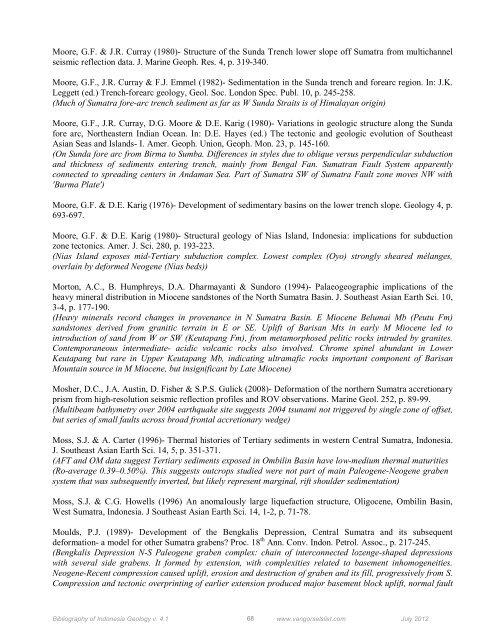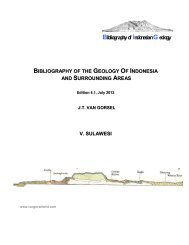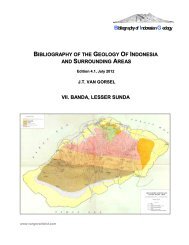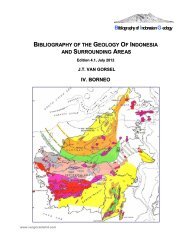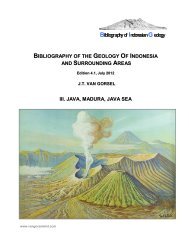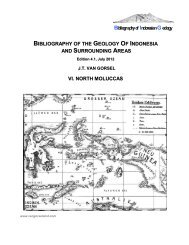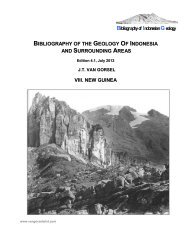Sumatra, Sunda Shelf, Natuna - Bibliography of Indonesia Geology
Sumatra, Sunda Shelf, Natuna - Bibliography of Indonesia Geology
Sumatra, Sunda Shelf, Natuna - Bibliography of Indonesia Geology
You also want an ePaper? Increase the reach of your titles
YUMPU automatically turns print PDFs into web optimized ePapers that Google loves.
Moore, G.F. & J.R. Curray (1980)- Structure <strong>of</strong> the <strong>Sunda</strong> Trench lower slope <strong>of</strong>f <strong>Sumatra</strong> from multichannel<br />
seismic reflection data. J. Marine Geoph. Res. 4, p. 319-340.<br />
Moore, G.F., J.R. Curray & F.J. Emmel (1982)- Sedimentation in the <strong>Sunda</strong> trench and forearc region. In: J.K.<br />
Leggett (ed.) Trench-forearc geology, Geol. Soc. London Spec. Publ. 10, p. 245-258.<br />
(Much <strong>of</strong> <strong>Sumatra</strong> fore-arc trench sediment as far as W <strong>Sunda</strong> Straits is <strong>of</strong> Himalayan origin)<br />
Moore, G.F., J.R. Curray, D.G. Moore & D.E. Karig (1980)- Variations in geologic structure along the <strong>Sunda</strong><br />
fore arc, Northeastern Indian Ocean. In: D.E. Hayes (ed.) The tectonic and geologic evolution <strong>of</strong> Southeast<br />
Asian Seas and Islands- I. Amer. Geoph. Union, Geoph. Mon. 23, p. 145-160.<br />
(On <strong>Sunda</strong> fore arc from Birma to Sumba. Differences in styles due to oblique versus perpendicular subduction<br />
and thickness <strong>of</strong> sediments entering trench, mainly from Bengal Fan. <strong>Sumatra</strong>n Fault System apparently<br />
connected to spreading centers in Andaman Sea. Part <strong>of</strong> <strong>Sumatra</strong> SW <strong>of</strong> <strong>Sumatra</strong> Fault zone moves NW with<br />
'Burma Plate')<br />
Moore, G.F. & D.E. Karig (1976)- Development <strong>of</strong> sedimentary basins on the lower trench slope. <strong>Geology</strong> 4, p.<br />
693-697.<br />
Moore, G.F. & D.E. Karig (1980)- Structural geology <strong>of</strong> Nias Island, <strong>Indonesia</strong>: implications for subduction<br />
zone tectonics. Amer. J. Sci. 280, p. 193-223.<br />
(Nias Island exposes mid-Tertiary subduction complex. Lowest complex (Oyo) strongly sheared mélanges,<br />
overlain by deformed Neogene (Nias beds))<br />
Morton, A.C., B. Humphreys, D.A. Dharmayanti & Sundoro (1994)- Palaeogeographic implications <strong>of</strong> the<br />
heavy mineral distribution in Miocene sandstones <strong>of</strong> the North <strong>Sumatra</strong> Basin. J. Southeast Asian Earth Sci. 10,<br />
3-4, p. 177-190.<br />
(Heavy minerals record changes in provenance in N <strong>Sumatra</strong> Basin. E Miocene Belumai Mb (Peutu Fm)<br />
sandstones derived from granitic terrain in E or SE. Uplift <strong>of</strong> Barisan Mts in early M Miocene led to<br />
introduction <strong>of</strong> sand from W or SW (Keutapang Fm), from metamorphosed pelitic rocks intruded by granites.<br />
Contemporaneous intermediate- acidic volcanic rocks also involved. Chrome spinel abundant in Lower<br />
Keutapang but rare in Upper Keutapang Mb, indicating ultramafic rocks important component <strong>of</strong> Barisan<br />
Mountain source in M Miocene, but insignificant by Late Miocene)<br />
Mosher, D.C., J.A. Austin, D. Fisher & S.P.S. Gulick (2008)- Deformation <strong>of</strong> the northern <strong>Sumatra</strong> accretionary<br />
prism from high-resolution seismic reflection pr<strong>of</strong>iles and ROV observations. Marine Geol. 252, p. 89-99.<br />
(Multibeam bathymetry over 2004 earthquake site suggests 2004 tsunami not triggered by single zone <strong>of</strong> <strong>of</strong>fset,<br />
but series <strong>of</strong> small faults across broad frontal accretionary wedge)<br />
Moss, S.J. & A. Carter (1996)- Thermal histories <strong>of</strong> Tertiary sediments in western Central <strong>Sumatra</strong>, <strong>Indonesia</strong>.<br />
J. Southeast Asian Earth Sci. 14, 5, p. 351-371.<br />
(AFT and OM data suggest Tertiary sediments exposed in Ombilin Basin have low-medium thermal maturities<br />
(Ro-average 0.39–0.50%). This suggests outcrops studied were not part <strong>of</strong> main Paleogene-Neogene graben<br />
system that was subsequently inverted, but likely represent marginal, rift shoulder sedimentation)<br />
Moss, S.J. & C.G. Howells (1996) An anomalously large liquefaction structure, Oligocene, Ombilin Basin,<br />
West <strong>Sumatra</strong>, <strong>Indonesia</strong>. J Southeast Asian Earth Sci. 14, 1-2, p. 71-78.<br />
Moulds, P.J. (1989)- Development <strong>of</strong> the Bengkalis Depression, Central <strong>Sumatra</strong> and its subsequent<br />
deformation- a model for other <strong>Sumatra</strong> grabens? Proc. 18 th Ann. Conv. Indon. Petrol. Assoc., p. 217-245.<br />
(Bengkalis Depression N-S Paleogene graben complex: chain <strong>of</strong> interconnected lozenge-shaped depressions<br />
with several side grabens. It formed by extension, with complexities related to basement inhomogeneities.<br />
Neogene-Recent compression caused uplift, erosion and destruction <strong>of</strong> graben and its fill, progressively from S.<br />
Compression and tectonic overprinting <strong>of</strong> earlier extension produced major basement block uplift, normal fault<br />
<strong>Bibliography</strong> <strong>of</strong> <strong>Indonesia</strong> <strong>Geology</strong> v. 4.1 68 www.vangorselslist.com July 2012


